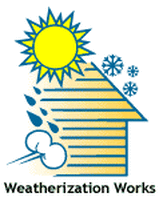 As the weather begins to turn from the heat of summer to the more pleasant temperatures of autumn, and before the cold sets in, it is the perfect time to think about weatherizing our homes. You’ll read throughout this newsletter the commitment that Red Feather is making to: educate people about the importance of weatherization, empower them to weatherize their homes, and ensure those who aren’t able to help themselves are not forgotten. You may ask yourself, why focus on weatherization? Or maybe even, what is it? We all know a shelter’s purpose is to keep us alive first, and comfortable second; and it does this by shielding us from all manner of unpleasant weather: cold, hot, wet, wind, etc. What weatherization does, is make a home more resilient to those outside conditions, while at the same time lowering the family’s energy bill. For those of us who are financially secure, we rarely consider what it takes to maintain a comfortable living environment. When the temperatures drop we just see a higher utility bill at the end of the month, pay it, and don’t give it much more thought. Imagine if changes in the weather meant your children would have less to eat, or you couldn’t afford the gas to get to work? Unfortunately, many in the tribes we serve struggle every winter to pay monthly heating bills. On average, households with incomes below the Federal Poverty Level pay 27% of their annual income simply on home energy bills. There are numerous important reasons for all of us to limit our energy consumption. The obvious reasons are the harmful effects that the mining and burning of fossil fuels has on the water we drink and the air we breathe. Here is one of the less obvious ways that weatherization helps the planet. For the communities we serve, the most common heating source is wood. Tribal woodsmen are having to drive their trucks farther and farther to harvest younger and younger trees to keep reservation homes warm during the winter. Even a small improvement in the energy efficiency of those homes can help begin to restore those forests. Forests that we so urgently need to clean our air. Finally, weatherization is an entry point for learning about home maintenance, and also draws the connection between home environment and occupant health. Our workshops not only build awareness of potential health and safety risks in the home, but also build the students’ confidence to address the smaller jobs themselves, and encourage collaboration with other community members for larger projects. We are forever grateful for the support from electrical utility provider, APS, which is enabling us to educate people and weatherize homes in Arizona, and likewise for the grant we received from the Shakopee Mdewakanton Sioux Community, which will allow us to teach a DIY Weatherization class for the Northern Cheyenne tribe in October. Where those funding sources leave off and your donations take-over is when we find problems in the homes of students that require more money to address. Your support is what enabled us to renovate the Curley family home which you will read about later in this newsletter. Please spread the word about this need and what we can all do together to address it. Please go to redfeather.og and “Donate Now.” Then stay tuned for an update on the families we were able to help together. Comments are closed.
|
Archives
June 2023
Categories
All
|
|
Change your mind at any time by clicking 'unsubscribe' in any email you receive or by contacting us at [email protected]. We will treat your information with respect. For more information about our privacy practices please see our privacy policy. By clicking above, you agree that we may process your information in accordance with these terms.
In compliance with all GDPR requirements- you can request any data you’ve shared with Red Feather to be permanently deleted from our records by contacting us at [email protected]. |
WORKING WITH HOPI AND DINÉ
COMMUNITIES FOR HEALTHIER AND SAFER HOMES.
LAND ACKNOWLEDGEMENT: The Red Feather program office sits in an area that is sacred to over 14 local tribes, including the Diné, Hopi, Havasupai, Hualapai, Zuni, Pueblo, and Kaibab-Paiute peoples. Some of these nations are represented among the Red Feather staff, and some not. We humbly acknowledge this area’s Indigenous nations, original stewards and Native descendants who will forever know this place as home. We share a responsibility to recognize and acknowledge the people, cultures, and histories that make up our community. *Adapted from the Flagstaff City Council land acknowledgement developed by the Indigenous Commission

If you have a disability that limits your ability to access our facilities, please contact us so we can arrange for an alternative meeting location. See our ADA access plan here.
This institution is an equal opportunity provider. |


 RSS Feed
RSS Feed

